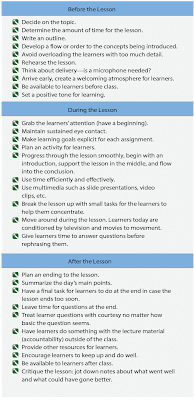Presentation of a Lesson
How does an instructor keep the attention of a class? The steps in Figure 1 form a guideline for lesson presentation. Many of them can be combined during the actual presentation. For example, consider a video presentation given during the weight and balance lecture. The video adds a multimedia element to the lecture, is a good attention getter, and can visually demonstrate the learning objective.
 |
| Figure 1. Guidelines for presenting lessons |
Organization of Material
After determining objectives and standards, an instructor formulates a plan of action to lead learners through the course in a logical manner toward the desired goal. Usually, the goal for learners is a certificate or rating. It could be a private pilot certificate, an instrument rating, an AMT certificate or, other rating. In all cases, a systematic plan of action requires the use of an appropriate training syllabus. Generally, the syllabus contains a description of each lesson, including objectives and completion standards.
The main concern of the instructor is usually organizing a block of training with integrated lesson plans. The traditional organization of a lesson plan is introduction, development, and conclusion.
Lesson Introduction
The introduction sets the stage for everything to come. Efforts in this area pay great dividends in terms of quality of instruction. In brief, the introduction is made up of three elements: attention, motivation, and an overview.
Attention
The purpose of the attention element is to focus each learner’s attention on the lesson. The instructor begins by telling a story, showing a video clip, asking a question, or telling a joke. Any of these may be appropriate at one time or another. Regardless of which is used, it should relate to the subject and establish a background for developing the learning outcomes. Telling a story or a joke unrelated in some way to the subject distracts from the lesson. The main concern is to focus everyone’s attention on the subject. [Figure 2]
 |
| Figure 2. The attention element causes learners to focus on the upcoming lesson |
Motivation
The motivation element offers the learners specific reasons why the lesson content is important to know, understand, apply, or perform and thus ensures readiness (Thorndike’s Law of Readiness). The instructor may provide examples where someone applied the knowledge or remind the learners of an upcoming assessment. The motivation should appeal to each learner personally and engender a desire to understand the material.
Overview
Every lesson introduction should contain an overview that tells the group what is to be covered during the period. A clear, concise presentation of the objective and the key ideas gives the learners a road map of the route to be followed. A good visual aid can help the instructor show the learners the path that they are to travel.
Development
Development is the main part of the lesson. Here, the instructor develops the subject matter in a manner that helps the learners achieve the desired outcomes. The instructor organizes the material logically to show the relationships of the main points. The instructor may show these primary relationships by developing the main points in one of the following ways: from past to present, simple to complex, known to unknown, and most frequently used to least used.
Past to Present
In this pattern of development, the subject matter is arranged chronologically, from the present to the past or from the past to the present. Time relationships are most suitable when history is an important consideration, as in tracing the development of radio navigation systems.
Simple-to-Complex
The simple-to-complex pattern helps the instructor lead the learner from simple facts or ideas to an understanding of the phenomena or concepts involved. When beginning a study of jet propulsion the learner might start by considering the forces involved when releasing air from a toy balloon and finish by taking part in a discussion of a complex gas turbine engine.
Do not be afraid to omit less important information at first in order to simplify the learning process. If Class D, E, and G airspace are the only airspace types being utilized by a learner, save the discussion of A, B, and C airspace until they have operating familiarity with the other types. Less information at first is easier to absorb.
Known to Unknown
By using something the learner already knows as the point of departure, the instructor can lead into new ideas and concepts. For example, when developing a lesson on heading indicators, the instructor could begin with a discussion of the magnetic compass before proceeding to a description of gyroscopic indicators.
Most Frequently Used to Least Used
In some subjects, certain information or concepts are common to all who use the material. This fourth organizational pattern starts with common usage before progressing to the rarer ones. Even though some aircraft are equipped with a computerized navigational system, instructors should begin by teaching learners the basics of navigation since all pilots use the basic skills.
Under each main point in a lesson, the subordinate points should lead naturally from one to another. With this arrangement, each point leads logically to and serves as a reminder of the next. Meaningful transition from one main point to another keeps the learners oriented, aware of where they have been, and where they are going. This permits learners to sort or categorize information in their working or short-term memory and allows them to process and remember what they have been taught.
Conclusion
An effective conclusion retraces the important elements of the lesson and relates them to the objective. This review and wrap-up of ideas reinforces learning and improves retention. New ideas should not be introduced in the conclusion because they are likely to confuse the learners.
By organizing the lesson material into a logical format, the instructor maximizes the opportunity for learners to retain the desired information. Since each teaching situation is unique, the setting and purpose of the lesson determines which teaching method is used.
